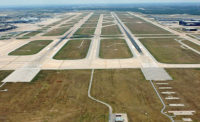In a jobsite trailer that serves the Terminal Renewal and Improvement Program at Dallas/Fort Worth International Airport, managers have created a memorial to construction site excess. A dozen rolls of outdated design development documents, each weighing 70 lb, are unused relics of how information was originally managed on the TRIP program when it kicked off just over a year ago.
During the past year, a construction joint venture that oversees $800 million in projects within the $1.9-billion TRIP program has gone completely paperless. Most notably, the initiative extends beyond office-bound designers, consultants and construction coordinators to include field staff. Rather than relying on printed documents, team members reach for iPads that put the entire project at their fingertips.
"When I think of the time it took to leaf through all of that paper to find the information we needed, it's hard to imagine working that way now," says Jeff Pistor, project manager at Balfour Beatty Construction, which, along with Azteca Enterprises, H.J. Russell & Co. and CARCON Industries, is part of the joint venture known as BARC. "Now our guys bring up whatever they need on an iPad. They have it wherever they go."
information overload
BARC is renovating two of the four terminals as part of the seven-year TRIP plan. Pistor says that once the team estimated the number of required documents coupled with the logistical challenges of moving around an active airport, the need for a mobile paperless solution became clear. "We started running the numbers and quickly got to 60,000 drawing sheets," he says. "They just kept ticking up. It was daunting."
Adding to the challenge, the team's jobsite trailer was located on the south side of the airport—1.5 miles from the first phase of work on Terminal A at the opposite end of the complex. Because terminal work is in secure areas, crews and trucks have to be screened by the Transportation Security Administration (TSA) every time they travel between the trailer and the jobsite. Pistor estimates that traveling round-trip between the two locations could take 30 minutes or more. "With four guys in a truck, that wasted time adds up quickly," he says.
Alternately, the team could have made another set of papers available at the terminal, which would have added significant printing costs to the budget.
In developing an iPad strategy, the team created a solution that Pistor says is more efficient, more accurate and less expensive. Ben Bringardner, assistant project manager of integrated projects at Balfour Beatty, says the company likely would have had at least two—possibly as many as four—full-sized sets of prints and another 10 or more half sets. Over the life of the project, they would have cost $30,000 and $9,000 each, respectively.
The savings are eye-catching: $180,000 in costs, 780,000 fewer pages printed and 33,000 fewer lb of paper used. That estimate does not take into account potential savings for subcontractors, owner representatives, designers and other parties that use iPads rather than paper, he says.
And the productivity savings may be even greater. "Our superintendents estimate that they are saving two hours a day," Bringardner says.







Post a comment to this article
Report Abusive Comment